List of Roman emperors facts for kids
Roman Emperors were the powerful leaders of the Roman Empire. They held control over all citizens and the army. The Roman Empire grew as the Roman Republic conquered and took over much of Europe, parts of North Africa, and Western Asia. Before emperors, the Republic was ruled by governors who answered to the Senate and the people of Rome.
The Republic ended when one person, Augustus, gained more power than all other leaders. Augustus became the first emperor. He was careful to pretend that the Republic still existed. He didn't take a special title for his position. Instead, he called himself Princeps Senatus, meaning "the first man of the senate."
This way of ruling lasted for about 300 years. It is known as the Principate era.
Later, in the late 200s AD, after a difficult time called the Crisis of the Third Century, Emperor Diocletian changed how the empire was run. This new period is called the 'Dominate'. During this time, the emperor's power became much more obvious. They even used the title 'Dominus Noster', which means 'Our Lord'.
As strong barbarian tribes grew along the empire's borders, defending the vast lands became harder. Diocletian decided to try sharing power. He split the imperial titles and duties among several people. For almost 200 years after that, there was often more than one emperor at a time. They often divided the huge empire to manage it better.
The Roman Empire and its line of emperors continued for a very long time. It finally ended with the death of Constantine XI. This happened when the Ottoman Empire captured Constantinople in 1453. Today, people often use the terms "Byzantium" or "Byzantine Empire" to talk about the Roman Empire during its medieval period. This is still a topic that experts discuss.
Contents
- The Principate: Early Emperors
- The Dominate: Later Emperors
- Eastern Emperors: The Byzantine Empire
- Leonid Dynasty (457–518 AD)
- Justinian Dynasty (518–602 AD)
- Non-dynastic (602–610 AD)
- Heraclian Dynasty (610–695 AD)
- Twenty Years' Anarchy (695–717 AD)
- Isaurian Dynasty (717–802 AD)
- Nikephorian Dynasty (802–813 AD)
- Non-dynastic (813–820 AD)
- Amorian Dynasty (820–867 AD)
- Macedonian Dynasty (867–1056 AD)
- Non-dynastic (1056–1057 AD)
- Komnenid Dynasty (1057–1059 AD)
- Doukid Dynasty (1059–1081 AD)
- Komnenid Dynasty (1081–1185 AD)
- Angelid Dynasty (1185–1204 AD)
- Laskarid Dynasty (1204–1261 AD, Empire of Nicaea)
- Palaiologan Dynasty (1261–1453 AD, restored to Constantinople)
- Claimants in Exile: Palaiologan Dynasty
- Images for kids
- See also
The Principate: Early Emperors
Julio-Claudian Dynasty (27 BC–68 AD)
This was the first family of emperors. They were all related to Augustus.
| Picture | Name | Born | How they became Emperor | Time as Emperor | Died | Years in power |
|---|---|---|---|---|---|---|
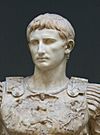 |
Augustus IMPERATOR CAESAR DIVI FILIVS AVGVSTVS |
September 23, 63 BC, Rome, Italy | He was the great-nephew and adopted son of Julius Caesar. He became the real emperor after making a deal with the Roman Senate. | January 16, 27 BC – August 19, 14 AD | August 19, 14 AD (aged 75) Natural causes |
40 years, 7 months and 3 days |
 |
Tiberius TIBERIVS CAESAR DIVI AVGVSTI FILIVS AVGVSTVS |
November 16, 42 BC, Rome | He was the natural son of Livia Drusilla, Augustus's third wife. He was adopted by Augustus as his son and heir. | September 18, 14 AD – March 16, 37 AD | March 16, 37 AD (aged 77) Probably natural causes, possibly murdered by others. |
22 years, 5 months and 27 days |
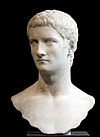 |
Caligula GAIVS IVLIVS CAESAR AVGVSTVS GERMANICVS |
August 31, 12 AD, Antium, Italy | He was the great-nephew and adopted grandson of Tiberius. He was also the great-grandson of Augustus. | March 18, 37 AD – January 24, 41 AD | January 24, 41 AD (aged 28) Murdered in a plot by senators and Praetorian Guards. |
3 years, 10 months and 6 days |
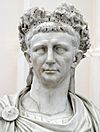 |
Claudius TIBERIVS CLAVDIVS CAESAR AVGVSTVS GERMANICVS |
August 1, 10 BC, Lugdunum, Gallia Lugdunensis | He was Caligula's uncle and Tiberius's nephew. The Praetorian Guard made him emperor. | January 25/26, 41 AD – October 13, 54 AD | October 13, 54 AD (aged 63) Probably poisoned by his wife Agrippina the Younger, so her son Nero could become emperor. |
13 years, 8 months and 18/19 days |
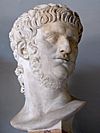 |
Nero NERO CLAVDIVS CAESAR AVGVSTVS GERMANICVS |
December 15, 37 AD, Antium, Italy | He was Claudius's great-nephew, stepson, and adopted son. He was also Augustus's great-great-grandson. | October 13, 54 AD – June 9, 68 AD | June 9, 68 AD (aged 30) He took his own life after the Senate declared him an enemy of the state. |
13 years, 7 months and 27 days |
Year of the Four Emperors and Flavian Dynasty (68–96 AD)
This period saw several emperors in a short time, followed by a new family.
| Picture | Name | Born | How they became Emperor | Time as Emperor | Died | Years in power |
|---|---|---|---|---|---|---|
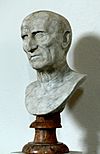 |
Galba SERVIVS SVLPICIVS GALBA CAESAR AVGVSTVS |
December 24 3 BC, Near Terracina, Italy | He took power after Nero's death, with the support of the Spanish armies. | June 8, 68 AD – January 15, 69 AD | January 15, 69 AD (aged 70) Murdered by the Praetorian Guard during a takeover led by Otho. |
7 months and 7 days |
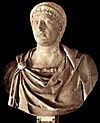 |
Otho MARCVS SALVIVS OTHO CAESAR AVGVSTVS |
April 28, 32 AD, Ferentinum, Italy | The Praetorian Guard appointed him. | January 15, 69 AD – April 16, 69 AD | April 16, 69 AD (aged 36) He took his own life after losing a battle to Vitellius. |
3 months and 1 day (91 days) |
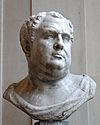 |
Vitellius AVLVS VITELLIVS GERMANICVS AVGVSTVS |
September 24, 15 AD, Rome | He took power with the support of the German armies, against Galba and Otho. | April 17, 69 AD – December 20, 69 AD | December 20, 69 AD (aged 54) Murdered by Vespasian's troops. |
8 months and 3 days |
 |
Vespasian TITVS FLAVIVS CAESAR VESPASIANVS AVGVSTVS |
November 17, 9 AD, Falacrine, Italy | He took power with the support of the eastern armies, against Vitellius. | December 21, 69 AD – June 24, 79 AD | June 24, 79 AD (aged 69) Natural causes |
9 years, 6 months and 3 days |
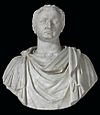 |
Titus TITVS FLAVIVS CAESAR VESPASIANVS AVGVSTVS |
December 30, 39 AD, Rome | He was the son of Vespasian. | June 24, 79 AD – September 13, 81 AD | September 13, 81 AD (aged 41) Natural causes (fever) |
2 years, 2 months and 20 days |
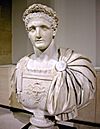 |
Domitian TITVS FLAVIVS CAESAR DOMITIANVS AVGVSTVS |
October 24, 51 AD, Rome | He was the son of Vespasian. | September 14, 81 AD – September 18, 96 AD | September 18, 96 AD (aged 44) Murdered by officials in the palace. |
15 years and 4 days |
Nerva–Antonine Dynasty (96–192 AD)
This dynasty is known for choosing skilled leaders, often by adoption.
| Picture | Name | Born | How they became Emperor | Time as Emperor | Died | Years in power |
|---|---|---|---|---|---|---|
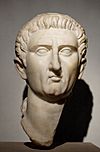 |
Nerva MARCVS COCCEIVS NERVA CAESAR AVGVSTVS |
November 8, 30 AD, Narni, Italy | The Senate chose him. | September 18, 96 AD – January 27, 98 AD | January 27, 98 AD (aged 67) Natural causes |
1 year, 4 months and 9 days |
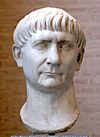 |
Trajan CAESAR MARCVS VLPIVS NERVA TRAIANVS AVGVSTVS |
September 18, 53 AD, Italica, Hispania Baetica | He was the adopted son and heir of Nerva. | January 28, 98 AD – August 7, 117 AD | August 7, 117 AD (aged 63) Natural causes |
19 years, 6 months and 10 days |
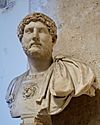 |
Hadrian CAESAR PVBLIVS AELIVS TRAIANVS HADRIANVS AVGVSTVS |
January 24, 76 AD, Italica, Hispania Baetica (or Rome) | He was the adopted son and heir of Trajan. | August 11, 117 AD – July 10, 138 AD | July 10, 138 AD (aged 62) Natural causes |
20 years, 10 months and 30 days |
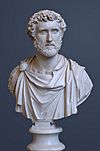 |
Antoninus Pius CAESAR TITVS AELIVS HADRIANVS ANTONINVS AVGVSTVS PIVS |
September 19, 86 AD, Near Lanuvium, Italy | He was the adopted son and heir of Hadrian. | July 10, 138 AD – March 7, 161 AD | March 7, 161 AD (aged 74) Natural causes |
22 years, 6 months and 28 days |
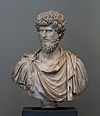 |
Lucius Verus CAESAR LVCIVS AVRELIVS VERVS AVGVSTVS |
December 15, 130 AD, Rome | He was the adopted son and heir of Antoninus Pius. He ruled as co-emperor with Marcus Aurelius until his death. | March 7, 161 AD – ? March 169 AD | March 169 AD (aged 39) Natural causes (possibly plague) |
8 years |
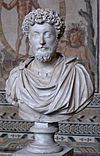 |
Marcus Aurelius CAESAR MARCVS AVRELIVS ANTONINVS AVGVSTVS |
April 26, 121 AD, Rome | He was the adopted son and heir of Antoninus Pius. He was co-emperor with Lucius Verus until 169 AD. | March 7, 161 AD – March 17, 180 AD | March 17, 180 AD (aged 58) Natural causes |
19 years and 10 days |
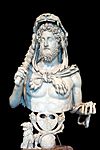 |
Commodus CAESAR MARCVS AVRELIVS COMMODVS ANTONINVS AVGVSTVS |
August 31, 161 AD, Lanuvium, Italy | He was the natural son of Marcus Aurelius. He became joint emperor in 177 AD. | 177 AD – December 31, 192 AD | December 31, 192 AD (aged 31) Murdered in the palace. |
3 years as joint emperor, 12 as sole emperor |
Year of the Five Emperors and Severan Dynasty (193–235 AD)
Another period of quick changes, followed by the Severan family.
| Picture | Name | Born | How they became Emperor | Time as Emperor | Died | Years in power |
|---|---|---|---|---|---|---|
 |
Pertinax CAESAR PVBLIVS HELVIVS PERTINAX AVGVSTVS |
August 1, 126 AD, Alba, Italy | The Praetorian Guard declared him emperor. | January 1, 193 AD – March 28, 193 AD | March 28, 193 AD (aged 66) Murdered by the Praetorian Guard. |
2 months and 27 days (86 days) |
 |
Didius Julianus CAESAR MARCVS DIDIVS SEVERVS IVLIANVS AVGVSTVS |
133 or 137 AD, Milan, Italy | He won an auction held by the Praetorian Guard for the emperor's position. | March 28, 193 AD – June 1, 193 AD | June 1, 193 AD (aged 56 or 60) Executed by order of the Senate. |
2 months and 4 days (65 days) |
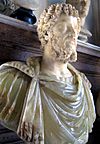 |
Septimius Severus CAESAR LVCIVS SEPTIMIVS SEVERVS PERTINAX AVGVSTVS |
April 11, 145 AD, Leptis Magna, Libya | He took power with the support of the Pannonian armies. | April 9, 193 AD – February 4, 211 AD | February 4, 211 AD (aged 65) Natural causes |
17 years, 9 months and 26 days |
 |
Caracalla CAESAR MARCVS AVRELIVS SEVERVS ANTONINVS PIVS AVGVSTVS |
April 4, 188 AD, Lugdunum, Gallia Lugdunensis | He was the son of Septimius Severus. He was co-emperor with his father from 198 AD, and with his brother Geta from 209 AD. | 198 AD – April 8, 217 AD | April 8, 217 AD (aged 29) Murdered by a soldier as part of a plot. |
13 years as joint emperor 10 months with Geta 6 years as sole emperor |
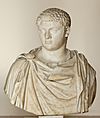 |
Geta CAESAR PVBLIVS SEPTIMIVS GETA AVGVSTUS |
March 7, 189 AD, Rome | He was the son of Septimius Severus. He was co-emperor with his father and Caracalla from 209 AD. | 209 AD – December 26, 211 AD | December 19, 211 AD (aged 22) Murdered by order of Caracalla. |
2 years as joint emperor 10 months with Caracalla |
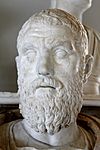 |
Macrinus MARCVS OPELLIVS SEVERVS MACRINVS AVGVSTVS PIVS FELIX with Diadumenian MARCVS OPELLIVS ANTONINVS DIADVMENIANVS |
c. 165 AD, Iol Caesarea, Mauretania | He was a high-ranking officer to Caracalla. He probably planned Caracalla's murder and then declared himself emperor. He made his son Diadumenian co-emperor. | April 11, 217 AD – June 8, 218 AD | June 8, 218 AD (aged 53) Both were executed in favor of Elagabalus. |
1 year, 1 month and 28 days |
 |
Elagabalus MARCVS AVRELIVS ANTONINVS AVGVSTVS |
c. 203 AD, Emesa, Syria | He was the grandson-in-law of Septimius Severus. Syrian armies declared him emperor. | June 8, 218 AD – March 11, 222 AD | March 11, 222 AD (aged 18) Murdered by the Praetorian Guard. |
3 years, 9 months and 3 days |
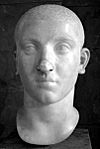 |
Severus Alexander CAESAR MARCVS AVRELIVS SEVERVS ALEXANDER AVGVSTVS |
October 1, 208 AD, Arca Caesarea, Syria | He was the cousin and adopted heir of Elagabalus. | March 13, 222 AD – March 18, 235 AD | March 18, 235 AD (aged 26) Murdered by the army. |
13 years and 5 days |
Crisis of the Third Century and Gordian Dynasty (235–285 AD)
This was a very unstable time with many different emperors.
| Picture | Name | Born | How they became Emperor | Time as Emperor | Died | Years in power |
|---|---|---|---|---|---|---|
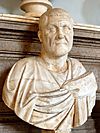 |
Maximinus Thrax CAESAR GAIVS IVLIVS VERVS MAXIMINVS AVGVSTVS |
c. 173 AD, Thrace or Moesia | German armies declared him emperor after Severus Alexander was murdered. | March 20, 235 AD – June 238 AD | June 238 AD (aged 65) Murdered by the Praetorian Guard. |
3 years, 3 months |
 |
Gordian I CAESAR MARCVS ANTONIVS GORDIANVS SEMPRONIANVS AFRICANVS AVGVSTVS |
c. 159 AD, Phrygia? | He was declared emperor during a revolt against Maximinus. He ruled with his son Gordian II. | March 22, 238 AD – April 12, 238 AD | April 238 AD (aged 79) He took his own life after hearing of his son's death. |
21 days |
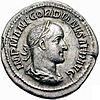 |
Gordian II CAESAR MARCVS ANTONIVS GORDIANVS SEMPRONIANVS ROMANVS AFRICANVS AVGVSTVS |
c. 192 AD, ? | He was declared emperor alongside his father Gordian I by the Senate. | March 22, 238 AD – April 12, 238 AD | April 238 AD (aged 46) Killed in battle against an army supporting Maximinus. |
21 days |
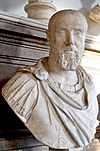 |
Pupienus CAESAR MARCVS CLODIVS PVPIENVS MAXIMVS AVGVSTVS |
c. 178 AD, ? | The Senate declared him joint emperor with Balbinus against Maximinus. | April 22, 238 AD – July 29, 238 AD | July 29, 238 AD (aged 68 or 73) Murdered by the Praetorian Guard. |
3 months and 7 days |
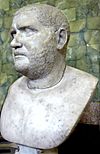 |
Balbinus CAESAR DECIMVS CAELIVS CALVINVS BALBINVS PIVS AVGVSTVS |
? | The Senate declared him joint emperor with Pupienus after the deaths of Gordian I and II. | April 22, 238 AD – July 29, 238 AD | July 29, 238 AD (aged 60) Murdered by the Praetorian Guard. |
3 months and 7 days |
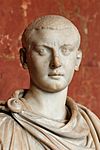 |
Gordian III CAESAR MARCVS ANTONIVS GORDIANVS AVGVSTVS |
January 20, 225 AD, Rome | He was declared emperor by supporters of Gordian I and II, then by the Senate. He was the grandson of Gordian I. | April 22, 238 AD – February 11, 244 AD | February 11, 244 AD (aged 19) Unknown; possibly murdered by order of Philip I. |
5 years, 9 months and 20 days |
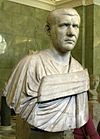 |
Philip the Arab CAESAR MARCVS IVLIVS PHILIPPVS AVGVSTVS with Philip II |
c. 204 AD, Shahba, Syria | He was a high-ranking officer to Gordian III. He took power after Gordian's death and made his son Philip II co-emperor. | February 244 AD – September/October 249 AD | September/October 249 AD (aged 45) Killed in battle by Decius. |
5 years |
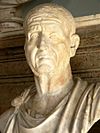 |
Decius CAESAR GAIVS MESSIVS QVINTVS TRAIANVS DECIVS AVGVSTVS with Herennius Etruscus |
c. 201 AD, Budalia, Pannonia Inferior | Armies declared him emperor. He defeated and killed Philip in battle. He made his son Herennius Etruscus co-emperor. | September/ October 249 AD – June 251 AD | June 251 AD (aged 50) Both killed in battle against the Goths. |
2 years |
 |
Hostilian CAESAR CAIVS VALENS HOSTILIANVS MESSIVS QVINTVS AVGVSTVS |
Sirmium | He was the son of Decius. The Senate accepted him as heir. | June 251 AD – late 251 AD | September/October 251 AD (aged 21) Natural causes (possibly plague). |
4–5 months |
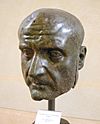 |
Trebonianus Gallus CAESAR GAIVS VIBIVS TREBONIANVS GALLVS AVGVSTVS with Volusianus |
206 AD, Italy | Armies declared him emperor after Decius's death. He made his son Volusianus co-emperor. | June 251 AD – August 253 AD | August 253 AD (aged 47) Murdered by their own troops. |
2 years |
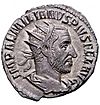 |
Aemilianus CAESAR MARCVS AEMILIVS AEMILIANVS AVGVSTVS |
c. 207 AD Africa | Armies declared him emperor after defeating the Goths. He was accepted as emperor after Gallus's death. | August 253 AD – October 253 AD | September/October 253 AD (aged 40 or 46) Murdered by his own troops. |
2 months |
| Valerian CAESAR PVBLIVS LICINIVS VALERIANVS AVGVSTVS |
c. 195 AD | Armies declared him emperor after Gallus's death. He was accepted as emperor after Aemilian's death. | October 253 AD – 260 AD | After 260 AD (aged 60) Captured by the Persians and died while imprisoned. |
7 years | |
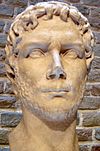 |
Gallienus CAESAR PVBLIVS LICINIVS EGNATIVS GALLIENVS AVGVSTVS with Saloninus |
218 AD | He was the son of Valerian and became co-emperor in 253 AD. His son Saloninus was briefly co-emperor. | October 253 AD – September 268 AD | September 268 AD (aged 50) Murdered by his own commanders. |
15 years |
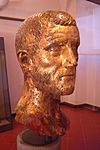 |
Claudius Gothicus CAESAR MARCVS AVRELIVS CLAVDIVS AVGVSTVS |
May 10, 213 AD/214 AD, Sirmium | He was a successful general who took power after Gallienus's death. | September 268 AD – January 270 AD | January 270 AD (aged 60) Natural causes (possibly plague). |
1 year, 4 months |
 |
Quintillus CAESAR MARCVS AVRELIVS CLAVDIVS QVINTILLVS AVGVSTVS |
?, Sirmium | He was the brother of Claudius Gothicus. He took power after his brother's death. | January 270 AD – September(?) 270 AD | 270 AD (aged 58) Unclear; possibly took his own life or was murdered. |
Unknown |
| Aurelian CAESAR LVCIVS DOMITIVS AVRELIANVS AVGVSTVS |
September 9, 214 AD/215 AD, Sirmium | Armies declared him emperor after Claudius II's death, against Quintillus. | September(?) 270 AD – September 275 AD | September 275 AD (aged 60-61) Murdered by the Praetorian Guard. |
5 years | |
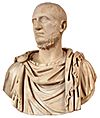 |
Tacitus CAESAR MARCVS CLAVDIVS TACITVS AVGVSTVS |
c. 200, Interamna Nahars, Italy | The Senate chose him to replace Aurelian after a short time without an emperor. | September 25, 275 AD – June 276 AD | June 276 AD (aged 76) Natural causes (possibly murdered). |
9 months |
| Florianus CAESAR MARCVS ANNIVS FLORIANVS AVGVSTVS |
? | He was the brother of Tacitus. The army in the west chose him to replace Tacitus. | June 276 AD – September? 276 AD | September? 276 AD Murdered by his own troops. |
3 months | |
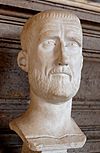 |
Probus CAESAR MARCVS AVRELIVS PROBVS AVGVSTVS |
232 AD, Sirmium | Armies declared him emperor against Florian. | September? 276 AD – September/ October 282 AD | September/ October 282 AD Murdered by his own troops. |
6 years |
 |
Carus CAESAR MARCVS AVRELIVS CARVS AVGVSTVS |
c. 230 AD, Narbo, Gallia Narbonensis | He was a high-ranking officer to Probus. He took power around the time Probus was murdered. He made his son Carinus co-emperor. | September/ October 282 AD – late July/ early August 283 AD | Late July/early August 283 AD Natural causes? (Possibly killed by lightning). |
10–11 months |
 |
Numerian CAESAR MARCVS AVRELIVS NVMERIVS NVMERIANVS AVGVSTVS |
? | He was the son of Carus. He became emperor jointly with his brother Carinus. | Late July/early August 283 AD – 284 AD? | 284 AD Unclear; possibly murdered. |
1 year |
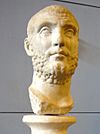 |
Carinus CAESAR MARCVS AVRELIVS CARINVS AVGVSTVS |
? | He was the son of Carus. He ruled briefly with his father and then with his brother Numerian. | Early 283 AD – 285 AD | 285 AD Died in battle against Diocletian? |
2 years |
The Dominate: Later Emperors
Tetrarchy and Constantinian Dynasty (284–364 AD)
This era began with shared rule (Tetrarchy) and then saw the rise of Constantine the Great.
| Picture | Name | Born | How they became Emperor | Time as Emperor | Died | Years in power |
|---|---|---|---|---|---|---|
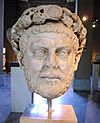 |
Diocletian CAESAR GAIVS AVRELIVS VALERIVS DIOCLETIANVS AVGVSTVS |
c. December 22, 244 AD, Salona | The army declared him emperor after Numerian's death. He made Maximian a senior co-emperor. | November 20, 284 AD – May 1, 305 AD | December 3, 311 AD He gave up his power and died of natural causes. |
20 years, 5 months and 11 days |
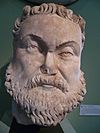 |
Maximian CAESAR MARCVS AVRELIVS VALERIVS MAXIMIANVS AVGVSTVS |
c. 250 AD, near Sirmium, Pannonia | Diocletian made him senior co-emperor in the west. | April 1, 286 AD – May 1, 305 AD | 310 AD He gave up his power, but tried to get it back. He was captured and took his own life. |
19 years and 1 month |
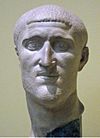 |
Constantius I CAESAR GAIVS FLAVIVS VALERIVS CONSTANTIVS AVGVSTVS |
March 31 c. 250 AD, Dardania, Moesia | Maximian adopted him as a junior co-emperor and heir. | May 1, 305 AD – July 25, 306 AD | 306 AD Natural causes |
1 year, 2 months and 24 days |
 |
Galerius CAESAR GALERIVS VALERIVS MAXIMIANVS AVGVSTVS |
c. 260 AD, Felix Romuliana, Moesia Superior | Diocletian adopted him as a junior co-emperor and heir. He was also Diocletian's son-in-law. | May 1, 305 AD – May 311 AD | 311 AD Natural causes |
6 years |
 |
Valerius Severus FLAVIVS VALERIVS SEVERVS AVGVSTVS |
? | Constantius I adopted him as a junior co-emperor and heir. He became Augustus in 306. | Summer 306 AD – March/ April 307 AD | September 16, 307 AD Captured by Maxentius and forced to take his own life (or murdered). |
1 year |
 |
Constantine the Great CAESAR FLAVIVS VALERIVS AVRELIVS CONSTANTINVS AVGVSTVS |
February 27 c. 272 AD, Naissus, Moesia Superior | He was the son of Constantius I. His father's troops declared him emperor. | July 25, 306 AD – May 22, 337 AD | May 22, 337 AD Natural causes |
30 years, 9 months and 27 days |
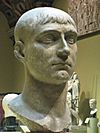 |
Maxentius MARCVS AVRELIVS VALERIVS MAXENTIVS AVGVSTVS |
c. 278 AD, ? | He was the son of Maximian. He took power in 306 after Constantius I's death. | October 28, 306 AD – October 28, 312 AD | October 28, 312 AD Died in battle against Constantine I. |
6 years |
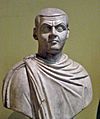 |
Maximinus II CAESAR GALERIVS VALERIVS MAXIMINVS AVGVSTVS |
November 20 c. 270 AD, Dacia Aureliana | He was the nephew of Galerius. He was adopted as Caesar and heir in 305 AD. | May 1, 311 AD – July/August 313 AD | July/August 313 AD Defeated in civil war; probably took his own life. |
2 years |
 |
Licinius I CAESAR GAIVS VALERIVS LICINIVS AVGVSTVS with Valerius Valens Martinian |
c. 250 AD, Felix Romuliana, Moesia Superior | He was the son-in-law of Constantius Chlorus. Galerius appointed him Augustus in the west. | November 11, 308 AD – September 18, 324 AD | 325 AD Defeated in civil war against Constantine I and executed. |
15 years, 10 months and 7 days |
 |
Constantine II CAESAR FLAVIVS CLAVDIVS CONSTANTINVS AVGVSTVS |
316 AD, Arelate, Gallia Narbonensis | He was the son of Constantine I. He became Caesar in 317 AD and then joint Augustus with his brothers. | May 22, 337 AD – 340 AD | 340 AD Died in battle against Constans I. |
3 years |
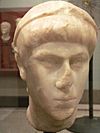 |
Constantius II CAESAR FLAVIVS IVLIVS CONSTANTIVS AVGVSTVS |
August 7, 317 AD, Sirmium, Pannonia | He was the son of Constantine I. He became joint Augustus with his brothers. | May 22, 337 AD – November 3, 361 AD | 361 AD Natural causes |
24 years, 5 months and 12 days |
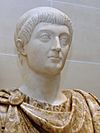 |
Constans I CAESAR FLAVIVS IVLIVS CONSTANS AVGVSTVS |
320 AD, ? | He was the son of Constantine I. He became joint Augustus with his brothers. | May 22, 337 AD – 350 AD | 350 AD Murdered by order of a rebel leader. |
13 years |
 |
Vetranio CAESAR FLAVIVS VETRANIO AVGVSTVS |
?, Moesia | He was a general of Constans I. He was declared Caesar against a rebel and temporarily accepted as Augustus. | March 1, 350 AD – December 25, 350 AD | c. 356 Died as a private citizen after giving up his power. |
9 months and 24 days |
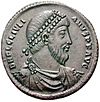 |
Julian CAESAR FLAVIVS CLAVDIVS IVLIANVS AVGVSTVS |
331 AD/332 AD, Constantinople, Thracia | He was the cousin of Constantius II. He became Caesar in 355 AD and then Augustus. | February 360 AD – June 26, 363 AD | June 26, 363 AD Seriously wounded in battle. |
3 years |
 |
Jovian CAESAR FLAVIVS IOVIANVS AVGVSTVS |
331 AD, Singidunum, Moesia | He was a general in Julian's army. The troops declared him emperor after Julian's death. | June 26, 363 AD – February 17, 364 AD | February 17, 364 AD Natural causes (suffocated on fumes). |
7 months and 22 days |
Valentinian Dynasty (364–392 AD)
This family ruled both the Western and Eastern parts of the Empire.
| Picture | Name | Born | How they became Emperor | Time as Emperor | Died | Years in power |
|---|---|---|---|---|---|---|
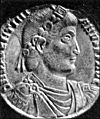 |
Valentinian I FLAVIVS VALENTINIANVS AVGVSTVS |
321 AD, Cibalae, Pannonia | The army chose him to replace Jovian. | February 26, 364 AD – November 17, 375 AD | November 17, 375 AD Natural causes |
11 years, 8 months and 22 days |
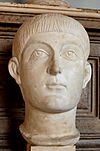 |
Valens FLAVIVS IVLIVS VALENS AVGVSTVS |
328 AD, Cibalae, Pannonia | He was the brother of Valentinian I. Valentinian made him co-Augustus for the east. | March 28, 364 AD – August 9, 378 AD | August 9, 378 AD Killed in battle against the Goths. |
14 years, 4 months and 12 days |
 |
Gratian FLAVIVS GRATIANVS AVGVSTVS |
April 18/May 23, 359 AD, Sirmium, Pannonia | He was the son of Valentinian I. His father made him a 'junior' Augustus. | August 4, 367 AD – August 25, 383 AD | August 25, 383 AD Murdered by a rebellious army group. |
16 years and 21 days |
 |
Valentinian II FLAVIVS VALENTINIANVS INVICTVS AVGVSTVS |
371 AD, Milan, Italy | He was the son of Valentinian I. The Pannonian army declared him emperor after his father's death. | November 17, 375 AD – May 15, 392 AD | May 15, 392 AD Unclear; possibly murdered or took his own life. |
16 years, 5 months and 28 days |
Theodosian Dynasty (379–457 AD)
This family oversaw the final division of the Roman Empire into Western and Eastern parts.
| Picture | Name | Born | How they became Emperor | Time as Emperor | Died | Years in power |
|---|---|---|---|---|---|---|
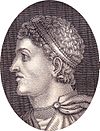 |
Theodosius I FLAVIVS THEODOSIVS AVGVSTVS |
January 11, 347 AD, Cauca, Hispania | He was the son-in-law of Valentinian I. Gratian appointed him Augustus for the east. | January 1, 379 AD – January 17, 395 AD | January 17, 395 AD Natural causes |
16 years and 16 days |
 |
Arcadius FLAVIVS ARCADIVS AVGVSTVS EAST |
c. 377 AD, Hispania | He was the son of Theodosius I. His father appointed him 'junior' Augustus for the east. | January 383 AD – May 1, 408 AD | May 1, 408 AD Natural causes |
25 years |
 |
Magnus Maximus with Flavius Victor WEST |
c. 335 AD, Hispania | He was a rebel leader in the West. Theodosius I later recognized him and his son Victor as emperors of Britain and Gaul. | 383/384 AD – August 28, 388 AD | August 28, 388 AD Executed by Theodosius I. Victor was killed by Arbogast. |
4/5 years |
 |
Honorius FLAVIVS HONORIVS AVGVSTVS WEST |
September 9, 384 AD, ? | He was the son of Theodosius I. His father appointed him 'junior' Augustus for the west. | January 23, 393 AD – August 15, 423 AD | August 15, 423 AD Natural causes |
30 years, 6 months and 23 days |
 |
Theodosius II FLAVIVS THEODOSIVS AVGVSTVS EAST |
April 10, 401 AD, Constantinople? | He was the son of Arcadius. His father appointed him 'junior' Augustus for the east. | January 402 AD – July 28, 450 AD | July 28, 450 AD Injuries from a hunting accident. |
48 years |
| Constantine III with Constans II WEST |
? | He was a rebel leader who declared himself emperor in the west. Honorius later recognized him as co-emperor. He made his son Constans II co-emperor. | 407/409 AD - August or September 411 AD | August or September 411 AD Executed by Constantius III. |
2 years | |
| Constantius III FLAVIVS CONSTANTIVS AVGVSTVS WEST |
?, Naissus, Moesia Superior | He married Theodosius I's daughter. Honorius made him co-Augustus for the west. | February 8, 421 AD – September 2, 421 AD | September 2, 421 AD Natural causes |
6 months and 25 days | |
| Joannes WEST |
? | He was a high-ranking civil servant. He was declared emperor by a supporter, but the Eastern Empire did not recognize him. | August 27, 423 AD – May 425 AD | June or July 425 AD Defeated in battle and executed. |
2 years | |
 |
Valentinian III FLAVIVS PLACIDIVS VALENTINIANVS AVGVSTVS WEST |
July 2, 419 AD, Ravenna, Italy | He was the son of Constantius III. Theodosius II appointed him Caesar for the west. | October 23, 424 AD – March 16, 455 AD | March 16, 455 AD Murdered, possibly by order of Petronius Maximus. |
30 years, 3 months and 24 days |
| Marcian FLAVIVS MARCIANVS AVGVSTVS EAST |
396, Thrace or Illyria | Pulcheria, sister of Theodosius II, chose him as her husband and successor. | Summer 450 AD – January 457 AD | January 457 AD Natural causes |
7 years |
The Last Emperors of the Western Empire (455–476 AD)
These emperors ruled the Western Roman Empire during its final years.
| Picture | Name | Born | How they became Emperor | Time as Emperor | Died | Years in power |
|---|---|---|---|---|---|---|
| Petronius Maximus FLAVIVS ANICIVS PETRONIVS MAXIMVS AVGVSTVS |
c. 396 AD, ? | He was the son-in-law of Theodosius II. He declared himself emperor with army support after Valentinian III's death. | March 17, 455 AD – May 31, 455 AD | May 31, 455 AD Murdered |
2 months and 14 days | |
| Avitus EPARCHIVS AVITVS AVGVSTVS |
c. 385 AD, ? | A military commander, he was declared emperor by the Visigoth king Theodoric II after Petronius's death. | July 9, 455 AD – October 17, 456 AD | after October 17, 456 AD Removed from power; later murdered. |
1 year, 3 months and 8 days | |
 |
Majorian IVLIVS VALERIVS MAIORIANVS AVGVSTVS |
November 420 AD, ? | His troops declared him emperor. The Eastern Empire recognized him. | April 457 AD – August 2, 461 AD | August 7, 461 AD Removed from power and executed. |
4 years |
 |
Libius Severus LIBIVS SEVERVS AVGVSTVS |
?, Lucania, Italy | Ricimer appointed him emperor. The Eastern Empire did not recognize him. | November 461 AD – August 465 AD | August 465 AD Probably poisoned. |
4 years |
 |
Anthemius PROCOPIVS ANTHEMIVS AVGVSTVS |
c. 420 AD | He was the son-in-law of Marcian. Leo I appointed him emperor. | April 12, 467 AD – July 11, 472 AD | July 11, 472 AD Executed by Ricimer or his nephew. |
5 years, 2 months and 29 days |
 |
Olybrius FLAVIVS ANICIVS OLYBRIVS AVGVSTVS |
c. 420 AD | He was the son-in-law of Valentinian III. Ricimer appointed him emperor. | July 11, 472 AD – November 2, 472 AD | November 2, 472 AD Natural causes |
3 months and 22 days |
 |
Glycerius FLAVIVS GLYCERIVS AVGVSTVS |
? | Gundobad appointed him emperor. The Eastern Empire did not recognize him. | March 473 AD – June 474 AD | after 480 AD Removed from power; time and manner of death unknown. |
1 year |
 |
Julius Nepos FLAVIVS IVLIVS NEPOS AVGVSTVS |
c. 430 AD | He was the nephew-in-law of the eastern emperor Leo I. He was appointed emperor against Glycerius. | June 474 AD – August 28, 475 AD (in Italy); – spring 480 AD (in Gaul and Dalmatia) | 480 AD Removed from power in Italy, but continued to rule in other areas until his murder. |
1 year/6 years |
 |
Romulus Augustulus ROMVLVS AVGVSTVS |
c. 460 AD, ? | His father, Orestes, appointed him. The Eastern Empire did not recognize him. | October 31, 475 AD – September 4, 476 AD (in Italy) | Unknown. He was removed from power by Odoacer. He likely lived out his life quietly. |
10 months and 4 days |
Eastern Emperors: The Byzantine Empire
After the Western Roman Empire ended, the Eastern part continued for another thousand years. This is often called the Byzantine Empire.
Leonid Dynasty (457–518 AD)
| Name | Time as Emperor | Important Facts | |
|---|---|---|---|
 |
Leo I "the Thracian" (Flavius Valerius Leo) |
February 7, 457 – January 18, 474 |
Leo became emperor after a general chose him. He was the first emperor crowned by the Patriarch of Constantinople. He helped bring peace to the borders and tried to take back land in the west. |
 |
Leo II "the Little" (Flavius Leo) |
January 18 – November 17, 474 |
He was the grandson of Leo I. He made his father, Zeno, co-emperor. He died shortly after, possibly poisoned. |
 |
Zeno (Flavius Zeno) |
November 17, 474 – April 9, 491 |
Zeno was a military leader who married Leo I's daughter. He became co-emperor with his son and then sole ruler. He made peace with some groups and saw the end of the Western Roman Empire. |
 |
Basiliscus (Flavius Basiliscus) |
January 9, 475 – August 476 |
He was a general and Leo I's brother-in-law. He took power from Zeno but was later removed by him. |
 |
Anastasius I (Flavius Anastasius) |
April 11, 491 – July 9, 518 |
He was a palace official chosen to be emperor by the empress. He improved the tax system and left the empire with extra money. His religious views caused some problems. |
Justinian Dynasty (518–602 AD)
| Name | Time as Emperor | Important Facts | |
|---|---|---|---|
 |
Justin I (Flavius Iustinus) |
July 518 – August 1, 527 |
He was an officer and commander of the bodyguard. The army and people chose him as emperor. |
 |
Justinian I "the Great" (Flavius Petrus Sabbatius Iustinianus) |
August 1, 527 – November 13/14, 565 |
He was Justin I's nephew. He became emperor after Justin I's death. His general, Belisarius, reconquered much of Europe. |
 |
Justin II (Flavius Iustinus Iunior) |
November 14, 565 – October 5, 578 |
He was Justinian I's nephew. He took the throne after Justinian's death. He later became unwell, and his wife and then Tiberius Constantine ruled for him. |
 |
Tiberius II Constantine (Flavius Tiberius Constantinus) |
October 5, 578 – August 14, 582 |
He was a commander and friend of Justin. He was named a junior emperor and then became emperor after Justin II's death. |
 |
Maurice (Flavius Mauricius Tiberius) |
August 14, 582 – November 22, 602 |
He was an official and general. He married Tiberius II's daughter and became emperor. He named his son Theodosius co-emperor. He was removed from power and executed. |
Non-dynastic (602–610 AD)
| Name | Time as Emperor | Important Facts | |
|---|---|---|---|
 |
Phocas (Φωκᾶς, Flavius Phocas) |
November 23, 602 – October 4, 610 |
He was a low-ranking officer who led a rebellion to remove Maurice. He became very unpopular and was removed from power and executed by Heraclius. |
Heraclian Dynasty (610–695 AD)
| Name | Time as Emperor | Important Facts | |
|---|---|---|---|
 |
Heraclius (Ἡράκλειος, Flavius Heraclius) |
October 5, 610 – February 11, 641 |
He was the eldest son of the governor of Africa. He led a revolt against Phocas and became emperor. He won a war against the Persians but couldn't stop the Muslim conquest of Syria. He made Greek the official language. |
 |
Constantine III formally Heraclius New Constantine (Ἡράκλειος νέος Κωνσταντῖνος, Heraclius Novus Constantinus) |
February 11 – May 24/26, 641 |
He was the eldest son of Heraclius. He became co-emperor with his younger brother after his father's death. He died of illness, possibly poisoned. |
 |
Heraklonas (Ἡρακλωνᾶς, Heraclianus) formally Constantine Heraclius (Κωνσταντίνος Ἡράκλειος, Constantinus Heraclius) |
February 11, 641 – September 641 |
He was Heraclius's son and became co-emperor. He was forced to name Constans II co-emperor and was later removed from power. |
 |
Constans II (Κῶνστας Β', Constantus II) formally Constantine "the Bearded", (Κωνσταντίνος ὁ Πωγωνάτος) |
September 641 – September 15, 668 |
He was the son of Constantine III. He became sole emperor after his uncle was removed. He moved his capital to Syracuse and was murdered there. He was the first emperor in a long time to visit Rome. |
 |
Constantine IV "the Bearded" (Κωνσταντίνος Δ' ὁ Πωγωνάτος) |
September 15, 668 – September 685 |
He became emperor after his father, Constans II, was murdered. He successfully defended Constantinople from the first Arab siege. |
 |
Justinian II (Ἰουστινιανὸς Β' ὁ Ῥινότμητος) |
September 685 – 695 |
He became sole emperor after Constantine IV's death. He was removed from power by a military revolt and sent away, but he later regained his throne. |
Twenty Years' Anarchy (695–717 AD)
This was a very chaotic time with many emperors rising and falling quickly.
| Name | Time as Emperor | Important Facts | |
|---|---|---|---|
 |
Leontios (Λεόντιος) |
695–698 | He was a general who removed Justinian II from power. He was later overthrown in another revolt and executed. |
 |
Tiberius III Apsimar (Τιβέριος Γ' Ἀψίμαρος) |
698–705 | He was an admiral who rebelled against Leontios. He ruled until Justinian II removed him from power. He was executed. |
 |
Justinian II (Ἰουστινιανὸς Β' ὁ Ῥινότμητος) |
August 705 – December 711 |
He returned to the throne with help from the Bulgars. He named his son Tiberius co-emperor. He was removed from power and killed by a military revolt. |
 |
Philippikos Bardanes (Φιλιππικὸς Βαρδάνης) |
December 711 – June 3, 713 |
He was a general who removed Justinian II. He was later overthrown by a revolt of his own troops. |
 |
Anastasios II (Ἀναστάσιος Β') |
June 713 – November 715 |
He was a government secretary who became emperor after Philippikos was overthrown. He was later removed by another military revolt. |
 |
Theodosios III (Θεοδόσιος Γ') |
May 715 – March 25, 717 |
He was a tax official who was declared emperor by rebellious troops. He later gave up his power and became a monk. |
Isaurian Dynasty (717–802 AD)
| Name | Time as Emperor | Important Facts | |
|---|---|---|---|
 |
Leo III "the Isaurian" (Λέων Γ΄ ὁ Ἴσαυρος) |
March 25, 717 – June 18, 741 |
He was a general who took the throne. He defended Constantinople from an Arab siege. He also started a period of religious debate about icons. |
 |
Constantine V "the Dung-named" (Κωνσταντῖνος Ε΄ ὁ Κοπρώνυμος) |
June 18, 741 – September 14, 775 |
He was the only son of Leo III. He continued his father's religious policies and won battles against the Arabs and Bulgars. |
| Artabasdos (Ἀρτάβασδος) |
June 741/742 – November 2, 743 |
He was a general and Leo III's son-in-law. He led a revolt and took Constantinople, but Constantine V defeated him. | |
 |
Leo IV "the Khazar" (Λέων Δ΄ ὁ Χάζαρος) |
September 14, 775 – September 8, 780 |
He was the eldest son of Constantine V. He became emperor after his father's death. |
 |
Constantine VI (Κωνσταντῖνος ΣΤ΄) |
September 8, 780 – August 797 |
He was the only child of Leo IV. His mother, Irene of Athens, ruled for him until 790. His mother later removed him from power and blinded him. |
| Irene of Athens (Εἰρήνη ἡ Αθηναία) |
August 797 – October 31, 802 |
She was the wife of Leo IV and mother of Constantine VI. She ruled for her son and later removed him to become empress herself. She was removed from power in a palace takeover. | |
Nikephorian Dynasty (802–813 AD)
| Name | Time as Emperor | Important Facts | |
|---|---|---|---|
 |
Nikephoros I "the Logothete" (Νικηφόρος Α΄ ὁ Λογοθέτης) |
October 31, 802 – July 26, 811 |
He was a finance minister under Irene. He led successful campaigns but was killed in battle. |
 |
Staurakios (Σταυράκιος) |
July 26, 811 – October 2, 811 |
He was the only son of Nikephoros I. He became emperor after his father's death but was badly wounded. He was forced to give up his power and died soon after. |
 |
Michael I Rangabe (Μιχαὴλ Α΄ Ραγγαβὲ) |
October 2, 811 – June 22, 813 |
He was Nikephoros I's son-in-law. He became emperor after Staurakios gave up power. He later gave up his power and became a monk. |
Non-dynastic (813–820 AD)
| Name | Time as Emperor | Important Facts | |
|---|---|---|---|
 |
Leo V "the Armenian" (Λέων Ε' ὁ Ἀρμένιος) |
July 11, 813 – December 25, 820 |
He was a general who rebelled against Michael I and became emperor. He brought back the religious debate about icons. He was murdered by a plot. |
Amorian Dynasty (820–867 AD)
| Name | Time as Emperor | Important Facts | |
|---|---|---|---|
 |
Michael II "the Amorian" (Μιχαὴλ Β΄ ὁ ἐξ Ἀμορίου) |
December 25, 820 – October 2, 829 |
He was an army officer who led the plot to murder Leo V. He faced rebellions and lost some territory to the Arabs. |
 |
Theophilos (Θεόφιλος) |
October 2, 829 – January 20, 842 |
He was the only son of Michael II. He became emperor after his father's death. |
 |
Michael III "the Drunkard" (Μιχαὴλ Γ΄ ὁ Μέθυσος) |
January 20, 842 – September 23, 867 |
He became emperor after Theophilos's death. His mother ruled for him for a time. He ended the religious debate about icons. He was murdered. |
Macedonian Dynasty (867–1056 AD)
This was a very successful dynasty that brought the empire to a high point.
| Name | Time as Emperor | Important Facts | |
|---|---|---|---|
| Basil I "the Macedonian" (Βασίλειος Α΄ ὁ Μακεδών) |
867 – August 2, 886 |
He rose through palace service and became a favorite of Michael III. He removed Michael and started the Macedonian dynasty. He won wars and regained some territory. | |
 |
Leo VI "the Wise" (Λέων ΣΤ΄ ὁ Σοφὸς) |
886 – May 11, 912 |
He was known for his learning. His reign saw many naval attacks and unsuccessful wars against the Bulgarians. |
 |
Alexander (Ἀλέξανδρος) |
May 11, 912 – June 6, 913 |
He was the son of Basil I. He became co-emperor and then sole emperor. He died after a polo game. |
 |
Constantine VII "the Purple-born" (Κωνσταντῖνος Ζ΄ ὁ Πορφυρογέννητος) |
June 6, 913 – November 9, 959 |
He was the son of Leo VI. His early rule was controlled by others, but he later took full control. He was known for encouraging learning and writing books about how the empire worked. |
| Romanos I Lekapenos (Ρωμανὸς Α΄ Λεκαπηνὸς) |
December 17, 920 – December 16, 944 |
He was an admiral who rose to power as a protector of young Constantine VII. He crowned himself senior emperor. His reign saw the end of war with Bulgaria and new conquests in the East. His sons later removed him from power. | |
| Romanos II "the Purple-born" (Ρωμανὸς Β΄ ὁ Πορφυρογέννητος) |
November 9, 959 – March 15, 963 |
He was the only surviving son of Constantine VII. His reign was marked by successful wars in the East and the regaining of Crete. | |
 |
Nikephoros II Phokas (Νικηφόρος Β΄ Φωκᾶς) |
August 16, 963 – December 11, 969 |
He was a very successful general. He became emperor and ruled for the young emperors. He led campaigns and conquered much of Syria. His nephew later murdered him. |
 |
John I Tzimiskes (Ἰωάννης Α΄ Κουρκούας ὁ Τσιμισκὴς) |
December 11, 969 – January 10, 976 |
He was Nikephoros Phokas's nephew and a successful general. He led a plot to murder his uncle and became emperor. He won battles against the Rus' and campaigned in the East. |
 |
Basil II "the Bulgar-Slayer" (Βασίλειος Β΄ ὁ Βουλγαροκτόνος) |
January 10, 976 – December 15, 1025 |
He was the eldest son of Romanos II. His reign was marked by wars against Bulgaria, which he finally conquered. He also expanded Byzantine control over Armenia. Many consider his rule the peak of the Byzantine Empire. |
| Constantine VIII "the Purple-born" (Κωνσταντῖνος Η΄ ὁ Πορφυρογέννητος) |
December 15, 1025 – November 15, 1028 |
He was the second son of Romanos II. During Basil II's rule, he enjoyed a relaxed life. During his short reign, he was not a strong ruler and was easily influenced. | |
 |
Zoe "the Purple-born" (Ζωὴ Πορφυρογέννητη) |
November 15, 1028 – June 1050 |
She was the daughter of Constantine VIII. She became empress after her father's death. Her three husbands ruled alongside her. |
| Romanos III Argyros (Ρωμανὸς Γ΄ Ἀργυρὸς) |
November 15, 1028 – April 11, 1034 |
He was an older noble chosen by Constantine VIII to marry Zoe and become emperor. | |
| Michael IV "the Paphlagonian" (Μιχαὴλ Δ΄ ὁ Παφλαγὼν) |
April 11, 1034 – December 10, 1041 |
He became Zoe's lover and then her husband and emperor after Romanos III's death. His reign had some success against rebellions. He died after a long illness. | |
| Michael V "the Caulker" (Μιχαὴλ Ε΄ ὁ Καλαφάτης) |
December 10, 1041 – April 20, 1042 |
He was Michael IV's nephew and adopted son. He tried to remove Zoe from power, but a public revolt forced him to restore her. He was removed from power the next day. | |
| Theodora (Θεοδώρα) |
April 19, 1042 – after August 31, 1056 |
She was Zoe's younger sister. She became co-ruler. After Zoe and Constantine IX died, Theodora ruled the empire fully until her death. | |
 |
Constantine IX Monomachos (Κωνσταντίνος Θ΄ Μονομάχος) |
June 11, 1042 – January 7/8 or 11, 1055 |
He was a noble chosen as Zoe's third husband. He liked intellectuals but upset the military leaders. His reign saw invasions and a major split between the churches of Rome and Constantinople. |
Non-dynastic (1056–1057 AD)
Komnenid Dynasty (1057–1059 AD)
| Name | Time as Emperor | Important Facts | |
|---|---|---|---|
| Isaac I Komnenos (Ἰσαάκιος Α΄ Κομνηνὸς) |
June 5, 1057 – November 22, 1059 |
He was a successful general who led a revolt and became emperor. He later resigned. | |
Doukid Dynasty (1059–1081 AD)
| Name | Time as Emperor | Important Facts | |
|---|---|---|---|
| Constantine X Doukas (Κωνσταντίνος Ι΄ Δούκας) |
November 24, 1059 – May 22, 1067 |
He was a general and ally of Isaac Komnenos. He became emperor after Isaac resigned. He named his sons co-emperors. | |
 |
Michael VII Doukas (Μιχαὴλ Ζ΄ Δούκας) |
May 22, 1067 – March 24, 1078 |
He was the eldest son of Constantine X. He became emperor after his father's death. His mother ruled for him for a time. He later gave up his power and became a monk. |
 |
Romanos IV Diogenes (Ρωμανὸς Δ΄ Διογένης) |
January 1, 1068 – October 24, 1071 |
He was a successful general who married the empress and became senior emperor. He was later removed from power and blinded. |
 |
Nikephoros III Botaneiates (Νικηφόρος Γ΄ Βοτανειάτης) |
March 31, 1078 – April 4, 1081 |
He was a general who rebelled against Michael VII and took the capital. He was later overthrown and retired to a monastery. |
Komnenid Dynasty (1081–1185 AD)
| Name | Time as Emperor | Important Facts | |
|---|---|---|---|
 |
Alexios I Komnenos (Ἀλέξιος Α' Κομνηνὸς) |
April 4, 1081 – August 15, 1118 |
He was a distinguished general who overthrew Nikephoros III. His reign was filled with wars against the Turks and the arrival of the First Crusade. |
 |
John II Komnenos (Ἰωάννης Β' Κομνηνὸς) |
August 15, 1118 – April 8, 1143 |
He was the eldest son of Alexios I. He became emperor after his father's death. His reign focused on wars with the Turks. He was known as "John the Good." |
 |
Manuel I Komnenos (Μανουὴλ Α' Κομνηνὸς) |
1143 – September 24, 1180 |
He was the third son of John II. His father chose him as emperor. He was an energetic ruler who launched many campaigns, but his spending weakened the empire. |
| [[File:Alexios II - komnenos.jpg|80="center"|Alexios II Komnenos (Ἀλέξιος B' Κομνηνὸς) |
September 24, 1180 – October 1183 |
He was the only son of Manuel I. His mother ruled for him for a time. He was later removed from power and killed. | |
 |
Andronikos I Komnenos (Ἀνδρόνικος Α' Κομνηνὸς) |
1183 – September 11, 1185 |
He was a nephew of John II. He was imprisoned for plotting against John II but escaped. He later took power from his nephew Alexios II. He was an unpopular ruler and was killed in a public uprising. |
Angelid Dynasty (1185–1204 AD)
| Name | Time as Emperor | Important Facts | |
|---|---|---|---|
 |
Isaac II Angelos (Ἰσαάκιος Β' Ἄγγελος) |
1185–1195 | He became emperor after a public revolt. His reign was marked by rebellions and wars. His older brother, Alexios III, removed him from power and blinded him. |
 |
Alexios III Angelos (Ἀλέξιος Γ' Ἄγγελος) |
1195 – July 17/18, 1203 |
He was the elder brother of Isaac II. His reign was marked by poor leadership and local leaders gaining more power. The Fourth Crusade removed him from power. |
 |
Isaac II Angelos (Ἰσαάκιος Β' Ἄγγελος) |
July 18, 1203 – January 27/28, 1204 |
The Crusaders restored him to his throne, but his son Alexios IV held the real power. He was removed from power and died shortly after. |
 |
Alexios IV Angelos (Ἀλέξιος Δ' Ἄγγελος) |
August 1, 1203 – January 27/28, 1204 |
He was the son of Isaac II. He asked the Fourth Crusade for help to put his father back on the throne. He ruled alongside his restored father. He was removed from power and killed. |
 |
Alexios V Doukas "Mourtzouphlos" (Ἀλέξιος Ε' Δούκας ὁ Μούρτζουφλος) |
February 5, 1204 – April 13, 1204 |
He was a prominent noble and Alexios III's son-in-law. He removed Isaac II and Alexios IV from power. He tried to fight off the Crusaders, but they captured Constantinople, forcing him to flee. He was later executed. |
Laskarid Dynasty (1204–1261 AD, Empire of Nicaea)
After Constantinople fell, the empire split. This family ruled from Nicaea, trying to restore the empire.
| Name | Time as Emperor | Important Facts | |
|---|---|---|---|
 |
Theodore I Laskaris (Θεόδωρος Α΄ Λάσκαρις) |
1205– December 1221/1222 |
He was Alexios III's son-in-law. He organized Greek resistance against the Latins after Constantinople fell. He became emperor and stopped Latin and Seljuk attacks, making Nicaea a strong Greek state. |
 |
John III Doukas Vatatzes (Ἰωάννης Γ' Δούκας Βατάτζης) |
December 15, 1221/1222– November 3, 1254 |
He was Theodore I's son-in-law and successor. He was a skilled ruler and soldier. He expanded his state by taking land from the Latin Empire, Bulgaria, and another Greek state. |
 |
Theodore II Laskaris (Θεόδωρος Β' Λάσκαρις) |
November 3, 1254– August 18, 1258 |
He was the only son of John III. He became emperor after his father's death. He won a victory against Bulgaria and expanded into Albania. |
 |
John IV Laskaris (Ἰωάννης Δ' Λάσκαρις) |
August 18, 1258– December 25, 1261 |
He was the only son of Theodore II. He became emperor after his father's death. Because he was young, Michael Palaiologos ruled for him. After Constantinople was retaken, Palaiologos removed John IV from power, blinded him, and imprisoned him. |
Palaiologan Dynasty (1261–1453 AD, restored to Constantinople)
This family restored the empire to Constantinople and ruled until its final fall.
| Name | Time as Emperor | Important Facts | |
|---|---|---|---|
 |
Michael VIII Palaiologos (Μιχαὴλ Η' Παλαιολόγος) |
January 1, 1259– December 11, 1282 |
He was a great-grandson of Alexios III. He became senior emperor alongside John IV and then sole emperor after retaking Constantinople. |
 |
Andronikos II Palaiologos (Ἀνδρόνικος Β' Παλαιολόγος) |
December 11, 1282– May 24, 1328 |
He was the son of Michael VIII. He became co-emperor and then sole emperor. He focused on religious matters and neglected the army, which led to the empire losing land in Asia Minor. His grandson later removed him from power. |
 |
Andronikos III Palaiologos (Ἀνδρόνικος Γ' Παλαιολόγος) |
May 24, 1328– June 15, 1341 |
He was the son of Michael IX. He became co-emperor and then removed his grandfather to rule alone. He had some successes in Europe, but faced defeats against the Ottomans. |
 |
John V Palaiologos (Ἰωάννης Ε' Παλαιολόγος) |
June 15, 1341– August 12, 1376 |
He was the only son of Andronikos III. His claim to the throne led to a civil war. He later had to recognize Ottoman rule. His son Andronikos IV removed him from power. |
 |
John VI Kantakouzenos (Ἰωάννης ΣΤ' Καντακουζηνὸς) |
February 8, 1347– December 4, 1354 |
He was a relative of the Palaiologoi family. He was declared co-emperor and later recognized as senior emperor after a civil war. John V later removed him from power. |
 |
Andronikos IV Palaiologos (Ἀνδρόνικος Δ΄ Παλαιολόγος) |
August 12, 1376– July 1, 1379 |
He was the son of John V. He removed his father from power but was later overthrown himself. He was recognized as co-emperor again later. |
 |
John V Palaiologos (Ἰωάννης Ε' Παλαιολόγος) |
July 1, 1379– April 14, 1390 |
He was restored as senior emperor. His grandson, John VII, later overthrew him again. |
 |
John VII Palaiologos (Ἰωάννης Ζ' Παλαιολόγος) |
April 14, 1390– September 17, 1390 |
He was the son of Andronikos IV. He took the throne from his grandfather John V for five months. He later governed a region of the empire. |
 |
John V Palaiologos (Ἰωάννης Ε' Παλαιολόγος) |
September 17, 1390– February 16, 1391 |
He was restored as senior emperor and ruled until his death. |
 |
Manuel II Palaiologos (Μανουὴλ Β' Παλαιολόγος) |
February 16, 1391 – July 21, 1425 |
He was the second son of John V. He became senior emperor after his father's death. He traveled to Western Europe to ask for help against the Turks. |
 |
John VIII Palaiologos (Ἰωάννης Η' Παλαιολόγος) |
July 21, 1425 – October 31, 1448 |
He was the eldest surviving son of Manuel II. He became emperor after his father's death. He tried to get help against the Ottomans by uniting the churches. He was the last Eastern emperor to visit Rome. |
 |
Constantine XI Palaiologos (Κωνσταντῖνος ΙΑ' Παλαιολόγος) |
January 6, 1449 – May 29, 1453 |
He was the fourth son of Manuel II. He became emperor after John VIII's death. He asked the West for help against the Ottoman sultan, Mehmed II, but it was not enough. He refused to surrender Constantinople and was killed during the final Ottoman attack. |
Claimants in Exile: Palaiologan Dynasty
After the fall of Constantinople, some members of the Palaiologan family still claimed the title of emperor.
| Picture | Name | Relation | Born | Claimed from | Claimed until | Died |
|---|---|---|---|---|---|---|
| Demetrios Palaiologos (Δημήτριος Παλαιολόγος) | Son of Manuel II, brother of John VIII and Constantine XI | c. 1407 | 1453 | 1460 | 1470 | |
 |
Thomas Palaiologos (Θωμᾶς Παλαιολόγος) | Son of Manuel II, brother of John VIII and Constantine XI | c. 1409 | 1453 | May 12, 1465 | |
| Andreas Palaiologos (Ἀνδρέας Παλαιολόγος) | Son of Thomas | c. 1453 | May 12, 1465 | 1502 | ||
Andreas died in poverty in 1502. He had sold his titles and royal rights to Ferdinand II of Aragon and Isabella I of Castile.
Images for kids
-
Coin of Pescennius Niger, a Roman rebel who claimed imperial power in 193–194 AD.
See also
 In Spanish: Anexo:Emperadores romanos para niños
In Spanish: Anexo:Emperadores romanos para niños



